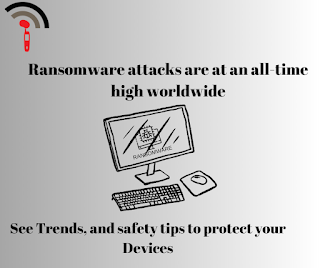--AD--
Global ransomware attacks are on the rise, based on a report by Malwarebytes. According to the report, there has been a sharp increase in attacks between July 2022 and June 2023, with the United States taking the biggest hit. According to the group, almost 43% of the 1,900 documented ransomware assaults come from the United States, up 75% from last year's figures. See trends and cybersecurity tips to protect your devices in this article.
Although at a slower rate than in the US, ransomware deployment increased in Germany, France, and the UK as well. The research lists 48 distinct ransomware groups that targeted American businesses, political institutions, and common consumers throughout the aforementioned time frame. What's worse? Institutions involved with healthcare and education suffered disproportionate damage. For instance, the New York City Department of Education was compromised in June, while the dental insurer Managed Care of North America (MCNA) suffered a breach back in March.
It's important to note that the Malwarebytes analysis only includes reported events; therefore, the actual number of attacks may be significantly higher than 1,900. Some businesses pay the ransom and keep things under wraps because the whole aim of a ransomware attack is to, well, extort a ransom.
An attack using ransomware is exactly what? It is malware that has been specifically created to prevent users and organizations from accessing files on a computer. When you pay the ransom, the software encrypts all of your data and gives you a decryption key so you can access them again. It is a digital heist.
The largest global offender is the Clop ransomware gang, which has long been thought to have connections to Russia. The criminal enterprise has advanced in the previous year, leveraging zero-day software flaws to broaden the scope of its attacks. In June, the organization broke into the servers of hundreds of businesses, including the biggest US pension fund, using one of these flaws in enterprise file transfer software.
Malwarebytes claims that the switch from phishing emails and virus-filled downloads to zero-day software exploits could "signal a change in the game" and account for the rise in reported instances.
The number of attacks in France over the previous year more than doubled compared to the rest of the world, with a disproportionate amount targeting governmental organizations. There were 200 attacks in the UK from 32 different organizations, with a worrying increase in frequency. The nation reported one ransomware incident each month in the previous year. It was eight per month in the most recent year.
Having known how the Ransomware operates, it is very important to know how you can protect yourself from becoming a victim. See how to protect your devices from getting infected below.
How Can I prevent Ransomware from my Computer?
A mix of preventative steps and sound cybersecurity practices are needed to protect oneself from ransomware. A form of software known as ransomware encrypts your files or locks you out of your computer until you pay the attackers a ransom. You can take the following actions to safeguard yourself from ransomware:
- Update your operating system, programs, and antivirus software on a regular basis. By doing this, security flaws that attackers might exploit are patched.
- Use Complex Passwords: Create strong, one-of-a-kind passwords for all of your accounts, and update them frequently. To create and securely store your passwords, think about utilizing a password manager.
- Set up two-factor authentication (2FA): Set up two-factor authentication for your accounts whenever it is possible. By requiring a second form of verification in addition to your password, this adds an additional degree of security.
- Regularly backup your vital data to a network-attached storage (NAS) device, the cloud, or an external hard drive. After the backup procedure, make sure to unplug your backups from your network to guard against security threats.
- Install reliable antivirus and anti-malware software, and make sure you keep it updated. With the aid of these technologies, ransomware infections can be found and avoided.
- Segment Your Network: If you have a home network, divide it into distinct segments for crucial and less-important devices. In the event that one device contracts ransomware, this can aid in restricting its spread.
- Macros should be disabled since they can be used to spread ransomware in office documents.
- Regularly Check for Suspicious activities: Keep an eye out for any indications of odd or illegal access on your network and device activities.
- Limit User Privileges: Only grant users the privileges required to complete their duties. This aids in limiting the network-wide transmission of malware.
- Use a Firewall: To prevent unauthorized access to your network and devices, use a firewall.
- Take Ransomware Protection Software into Account: Some security software specializes in ransomware defense. Look into and think about employing such tools to strengthen your defense.
- Implement Email Filters: To prevent phishing and malicious emails from reaching your inbox, use email filtering systems.
- Stay Informed: To better defend yourself against emerging attack strategies, keep abreast of the most recent ransomware threats and trends.
Although no security solution is infallible, you may dramatically lower your risk of being a victim of ransomware attacks by putting these tips into practice.


Comments
Post a Comment
Important - If you ask a question make sure you tick the "Notify Me" box below the comment form to be notified of follow up comments and replies.